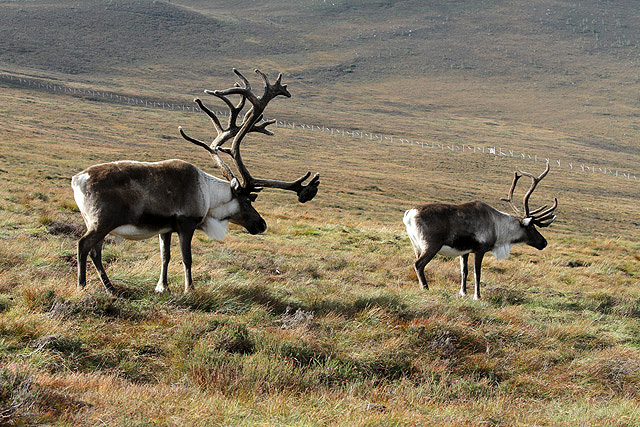Some animals sport some truly impressive headgear, from antlers the size of a small tree to robust horns. However, though they are similar, there are important differences between horns and antlers in how they are formed and of what they are made.
Antlers
Antlers are found exclusively in the Cervidae family, which is made up of deer and their relatives. Male deer have two small, bony structures on top of their heads that are called pedicles. The antlers grow out of the pedicles. Antlers are made of bone and are coated in “velvet”, a thin fuzzy layer of skin and blood vessels. Velvet supplies oxygen and blood to the antlers as they grow. When the antlers have grown to their full size, the velvet dies off. Each year, the deer shed their antlers and grow a new pair. Yes, it’s true; those crazy antlers grow in just one season!

Antlers are mainly used to attract females and to fight against other males over leadership. Indeed, sexual selection is the main reason for their evolution, through direct male competition for females, as a symbol of dominance, and through female selection. Males with larger antlers are considered fitter because of their position as alpha males. Additionally, antlers are indicators of good metabolic efficiency and food gathering, desirable traits for a future reproductive partner.
However, antlers are not just used in acquiring a mate. They are used for protection against predators, such as wolves. Wolves are more likely to attack and kill male elk without antlers that those with them.
Antlers also have a special function for moose. Basically, they act like giant hearing aids. Apparently, moose with antlers can hear better than those without them.

Reindeer use their antlers to clear away snow to eat plants hiding underneath. For this reason, both males and females grow antlers, though the females’ antlers are smaller. It is the only species where both the sexes have antlers. Males shed their antlers before winter, while females keep their antlers through winter, possibly because they compete with other females during winter foraging.
Horns
In contrast to antlers, horns are kept for life; they are never shed. Members of the family Bovidae (cows, goats, antelopes etc) grow horns. Horns have a full bone core and are covered in keratin, the same substance that makes up human fingernails. Horns usually have a curved or spiral shape with ridges. They start to grow soon after the animal is born and grow across the animal’s whole lifetime. If they are damaged or removed, they do not re-grow.

Males and females can both have horns though it is more usual for males. The theory is that larger species living in the open, like large herbivores in the savannah, are more visible to predators. Therefore, both males and females both usually have horns to defend themselves.
Horns typically grow in symmetrical pairs. Usually, animals only have one set of horns but there are some interesting sheep breeds that possess multiple sets of horns, such as the Hebridean, Islandic and Navajo-Churro breeds.

Animals use horns primarily for defending themselves from predators, and even fighting members of their own species for territory, dominance, or a mate. They can also be used for functional purposes, such as digging in the soil or stripping bark from trees. Horns might even work as a cooling system for animals, with the blood vessels in the bony core of the horn letting off heat.
Other
Though horns and antlers are the most common cranial appendages, there are some other types. Giraffes and okapis have little bony growths called ossicones. The ossicones start out as cartilage growth and then eventually harden so that by the time the animal reaches puberty, the growths have hardened into bone and fused to the skull. They are usually covered in skin and fur, though the tips of ossicones in okapis sometimes have bare tips.
Pronghorns also have a special type of headgear that mixes characteristics typical of both horns and antlers. They are like horns in that the core is bone with a keratin covering, but they branch out and get shed annually like antlers.

Though they are valuable, rhino “horns” are actually not true horns. They are entirely formed out of keratin and do not have a bone core as horns do. They can also grow back after if a stump is left. Apparently, if a rhino’s horn is regularly trimmed every 18 months, a rhino will grow 130 pounds (59 kg) of horn over its full life span.
The hard truth is that horns and antlers have a similar function, though antlers are perhaps a greater metabolic feat as they are grown every single year from scratch. They are both composed of bone, but horns also have a keratin covering. Here’s to some truly impressive cranial appendages!






